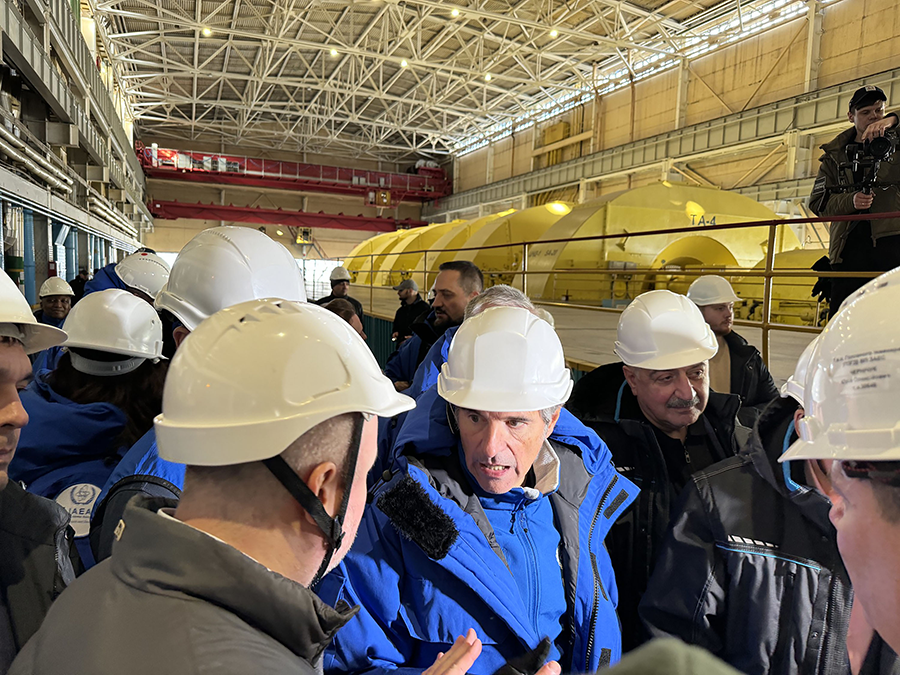Russia Bars Ukrainian Operators From Zaporizhzhia
March 2024
By Kelsey Davenport
The head of the International Atomic Energy Agency (IAEA) has raised concerns that Russia’s decision to cut staff at the Russian-occupied Zaporizhzhia Nuclear Power Plant is compromising nuclear safety and security.
 IAEA Director-General Rafael Mariano Grossi visited the facility on Feb. 7, a week after Russia announced that workers employed by Energoatom, the Ukrainian nuclear energy company, would no longer be allowed to work at the site.
IAEA Director-General Rafael Mariano Grossi visited the facility on Feb. 7, a week after Russia announced that workers employed by Energoatom, the Ukrainian nuclear energy company, would no longer be allowed to work at the site.
After Russia illegally attacked and occupied the Zaporizhzhia complex in March 2022 as part of its full-scale invasion of Ukraine, it brought in employees from Rosatom, the Russian state-run nuclear company, to operate the nuclear power plant and pressured Ukrainian employees to sign contracts with Rosatom. Until Feb. 1, 120 Energoatom employees were still working there. Following the announcement, Russia informed the IAEA that it had sufficient personnel to run the facility without the 120 Energoatom staffers. Russia said it was necessary to bar Energoatom employees from the site to operate the plant in line with Russian regulations.
After his visit, Grossi said the number of staff is “significantly reduced” from prewar levels and warned that even though the reactor units are in shutdown mode, “the plant still requires sufficient numbers of qualified personnel to conduct both operational tasks and to ensure that equipment important for nuclear safety and security is properly maintained.”
Prior to visiting the Zaporizhzhia plant, Grossi met with Ukrainian President Volodymyr Zelenskyy and various Ukrainian officials, including Petro Kotin, the head of Energoatom. Grossi said his agency is working to “assess the operational impact of this [Russian] decision.” There is “absolutely no place for complacency” regarding the security and safety of the facility, he said.
In January, the IAEA team at the Zaporizhzhia complex notified the agency that Russia mined the area between the internal and external fences surrounding the site. Russia previously had placed landmines in that zone, but removed them in November 2023.
In a Jan. 19 statement, Grossi said the use of landmines is inconsistent with IAEA standards for nuclear safety.
Russia defended its decision in a Jan. 31 statement to the IAEA, saying that landmines “do not pose any threat to personnel” at the Zaporizhzhia plant and that their use “does not contradict any IAEA recommendations.”
Russia said that landmines are necessary “to deter potential saboteurs.” It argued that deterring sabotage “corresponds” to the five IAEA principles for ensuring the safety and security of the plant, specifically that all structures at the facility must be “protected from attacks or acts of sabotage.” Grossi introduced the five principles at a UN Security Council meeting in May 2023 and continues to reiterate their importance. (See ACT, June 2023.)
In addition to staffing and landmines, Grossi raised additional concerns about nuclear safety and security during a Jan. 25 briefing to the Security Council. He said that the IAEA expert team at the Zaporizhzhia site “has not had timely access to some areas of the plant” and stressed that access is necessary to “effectively conduct” assessments of safety and security.
After the Feb. 8 visit, Grossi emphasized that IAEA personnel must be able to ask questions about conditions at the site. He said that “there were situations where there were suggestions that [agency experts should] look but not talk.” Preventing questions “is not good,” Grossi said.
